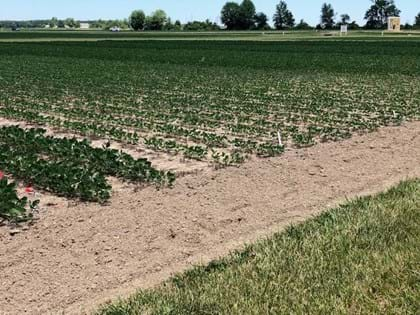Product and Agronomy Research (PAR) Results: Soybean Planting Date
BY Dairyland Seed Agronomy Team
SOYBEAN PLANTING DATE
Description:
Early planting for soybeans has been a much-discussed agronomic topic for several years. Some studies suggest a possible yield increase with earlier planting. This leads to growers asking every year if soybeans or corn should be planted first. In this demonstration we are comparing various planting dates for soybeans and different soybean varieties. This study was conducted in 2021 and 2022 at both the Wabash and St. Johns locations.

Wabash, IN
DSR-2640E, DSR-2717E, DSR-3177E and DSR-3499E were planted at 130,000 seeds per acre in 30-inch rows with standard management across all treatments. Target planting dates were mid-April, late-April, mid-May and early-June. Cool and wet weather this spring slightly delayed some of the planting dates.
Treatments:
- April 23
- May 12
- May 19
- June 1
St. Johns, MI
DSR-1505E and DSR-2717E were planted at 135,000 seeds per acre in 30-inch rows with standard management across all treatments. Target planting dates were mid-April, late-April, mid-May and early-June.
Treatments:
- April 20
- April 29
- May 12
- June 1
Results:
|
2022 Soybean Yield by Planting Date |
|||
|
Date |
Location |
Variety |
BU/A |
|
4/20/2022 |
St. Johns |
DSR-1505E |
52.5 |
|
4/20/2022 |
St. Johns |
DSR-2717E |
60.4 |
|
4/23/2022 |
Wabash |
DSR-2640E |
73.3 |
|
4/23/2022 |
Wabash |
DSR-2717E |
75.5 |
|
4/23/2022 |
Wabash |
DSR-3177E |
68.9 |
|
4/23/2022 |
Wabash |
DSR-3499E |
85.3 |
|
Mid-April |
|
|
66.1 |
|
4/29/2022 |
St. Johns |
DSR-1505E |
55.7 |
|
4/29/2022 |
St. Johns |
DSR-2717E |
54.2 |
|
5/12/2022 |
Wabash |
DSR-2640E |
69.8 |
|
5/12/2022 |
Wabash |
DSR-2717E |
69.6 |
|
5/12/2022 |
Wabash |
DSR-3177E |
72.1 |
|
5/12/2022 |
Wabash |
DSR-3499E |
81.5 |
|
Late April/Early May |
|
64.1 |
|
|
5/12/2022 |
St. Johns |
DSR-1505E |
56.7 |
|
5/12/2022 |
St. Johns |
DSR-2717E |
58.2 |
|
5/19/2022 |
Wabash |
DSR-2640E |
69.0 |
|
5/19/2022 |
Wabash |
DSR-2717E |
70.7 |
|
5/19/2022 |
Wabash |
DSR-3177E |
73.2 |
|
5/19/2022 |
Wabash |
DSR-3499E |
78.3 |
|
Mid-May |
|
|
65.1 |
|
6/1/2022 |
St. Johns |
DSR-1505E |
48.6 |
|
6/1/2022 |
St. Johns |
DSR-2717E |
52.3 |
|
6/1/2022 |
Wabash |
DSR-2640E |
65.3 |
|
6/1/2022 |
Wabash |
DSR-2717E |
64.1 |
|
6/1/2022 |
Wabash |
DSR-3177E |
66.8 |
|
6/1/2022 |
Wabash |
DSR-3499E |
77.3 |
|
Early June |
|
|
59.4 |
|
2021 Soybean Yield by Planting Date |
|||
|
Date |
Location |
Variety |
BU/A |
|
4/5/2021 |
Wabash |
DSR-3177E |
71.5 |
|
4/5/2021 |
Wabash |
DSR-3587E |
72.9 |
|
4/14/2021 |
St. Johns |
DSR-2640E |
65.1 |
|
4/14/2021 |
St. Johns |
DSR-2040E |
64.3 |
|
Early April |
|
|
68.4 |
|
4/23/2021 |
Wabash |
DSR-3177E |
71.5 |
|
4/23/2021 |
Wabash |
DSR-3587E |
69.6 |
|
4/30/2021 |
St. Johns |
DSR-2640E |
69.5 |
|
4/30/2021 |
St. Johns |
DSR-2040E |
63.8 |
|
Late April |
|
|
68.6 |
|
5/15/2021 |
Wabash |
DSR-3177E |
70.5 |
|
5/15/2021 |
Wabash |
DSR-3587E |
72.2 |
|
5/15/2021 |
St. Johns |
DSR-2640E |
72.0 |
|
5/15/2021 |
St. Johns |
DSR-2040E |
64.5 |
|
Early May |
|
|
69.8 |
|
5/25/2021 |
Wabash |
DSR-3177E |
67.7 |
|
5/25/2021 |
Wabash |
DSR-3587E |
66.5 |
|
6/1/2021 |
St. Johns |
DSR-2640E |
68.3 |
|
6/1/2021 |
St. Johns |
DSR-2040E |
61.6 |
|
Late May |
|
|
66.0 |
Conclusion:
Results this year indicate the mid-April to mid-May planting dates yielded similar and were significantly higher than the June 1 planting. The 2021 data showed similar results with the lowest yields in the late May/early June planting date. Although soybean emergence can be reduced in early planting, the remaining plants are capable of branching and setting pods to make up for the lost plants. It is important to note that adequate soil conditions are necessary for determining when to plant. Planting ultra-early in conditions that are too wet or cold can result in chilling injury, reduced vigor, and seed mortality. The results from this study and other industry studies supports planting soybeans early, along as soil conditions are adequate, and waiting for more favorable conditions to begin planting corn.
